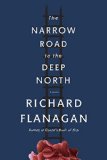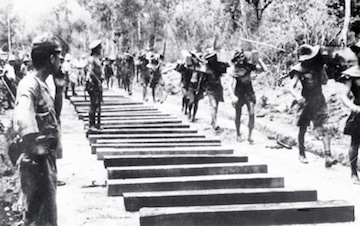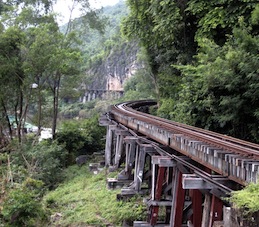Summary | Excerpt | Reading Guide | Reviews | Beyond the Book | Read-Alikes | Genres & Themes | Author Bio

Critics' Opinion:
Readers' Opinion:
First Published:
Aug 2014, 352 pages
Paperback:
Apr 2015, 352 pages
 Book Reviewed by:
Book Reviewed by:
Alta Ifland
Buy This Book
This article relates to The Narrow Road to the Deep North
 Richard Flanagan's novel The Narrow Road to the Deep North is based on a terrible chapter from WWII: the construction, under Japanese supervision, of a railway between Thailand and Burma by Allied prisoners of war and local workers. The slave labor conditions and the tortures experienced by the forced laborers claimed the lives of 13,000 Allied prisoners and 90,000 Asians.
Richard Flanagan's novel The Narrow Road to the Deep North is based on a terrible chapter from WWII: the construction, under Japanese supervision, of a railway between Thailand and Burma by Allied prisoners of war and local workers. The slave labor conditions and the tortures experienced by the forced laborers claimed the lives of 13,000 Allied prisoners and 90,000 Asians.
The prisoners were forced to march through the jungle along the railway (the "Line"), which followed the course of the river Kwai whenever possible, and labor camps were set up at various points. At the so-called Hellfire Pass, the railway had to cut through the mountains, and the laborers were forced to do the work with minimal construction equipment. As a consequence, this camp, together with the one at the Sankorei bridge, were responsible for thousands of deaths.
 In January 1943, the Japanese issued an order called Speedo, which was meant to hasten the construction of the railway at any price. This order, which haunts Flanagan's novel, forced sick prisoners, who could barely stand, to get up and work, and was thus responsible for numerous deaths. In addition to the deaths caused by exhaustion, starvation, malaria, cholera, dysentery and various infections, many prisoners died of beatings (one such beating is documented in Flanagan's novel in a description that goes on for several chapters). The guards, mostly Korean, used bamboo sticks to enforce discipline. A few photos, taken in secret, show skeletal prisoners comparable to those seen in Nazi concentration camps.
In January 1943, the Japanese issued an order called Speedo, which was meant to hasten the construction of the railway at any price. This order, which haunts Flanagan's novel, forced sick prisoners, who could barely stand, to get up and work, and was thus responsible for numerous deaths. In addition to the deaths caused by exhaustion, starvation, malaria, cholera, dysentery and various infections, many prisoners died of beatings (one such beating is documented in Flanagan's novel in a description that goes on for several chapters). The guards, mostly Korean, used bamboo sticks to enforce discipline. A few photos, taken in secret, show skeletal prisoners comparable to those seen in Nazi concentration camps.
The railway was built under these conditions in only sixteen months, using iron from railways that had been taken apart in Java, Singapore and Malaya, and then transported to Siam (Thailand). According to some experts, and given the circumstances, it represented an amazing achievement from a technical standpoint. Even today, Japanese veterans talk about it with pride because they succeeded in doing something the Europeans had unsuccessfully tried (in the past, the British had considered building a railway there, but gave it up), so the railway represented a triumph of the Japanese spirit. In 1943, the Allies bombed the Line, but without success, and it was this episode that prompted the Americans to develop the so-called "smart bombs." In 1945, American forces finally destroyed the bridge.
A famous Hollywood movie, The Bridge on the River Kwai (based on the book by the same name), immortalized the Death Railway, but it is important to note that, although it portrays the horrible conditions laborers were forced to endure during the building of the railway and its bridges, not much else is historically accurate. In fact, the bridge in the movie is most similar to a wooden trestle bridge in the jungle, many miles away from the railway.
 Ronald Searle (1920-2011), the British cartoonist best known for his humorous St. Trinian's schoolgirl illustrations, rejected the movie, calling it "the 'jolly good chaps' account" of this horrific historical event. He spoke from experience. Searle was a POW in Japan and served as a laborer on the Death Railway in 1943. During this time, he endured regular beatings, bouts of malaria and beriberi (a disease that causes inflammation of the nerves and sometimes heart failure due to a vitamin B1 deficiency) and his weight dropped to 84 pounds. He was not alone in suffering these things. But he was alone in documenting them. He drew what he saw, and hid his work under the mattresses of sick laborers, so the Japanese guards wouldn't find them. "I desperately wanted to put down what was happening, because I thought if by any chance there was a record, even if I died, someone might find it and know what went on," he said.
Ronald Searle (1920-2011), the British cartoonist best known for his humorous St. Trinian's schoolgirl illustrations, rejected the movie, calling it "the 'jolly good chaps' account" of this horrific historical event. He spoke from experience. Searle was a POW in Japan and served as a laborer on the Death Railway in 1943. During this time, he endured regular beatings, bouts of malaria and beriberi (a disease that causes inflammation of the nerves and sometimes heart failure due to a vitamin B1 deficiency) and his weight dropped to 84 pounds. He was not alone in suffering these things. But he was alone in documenting them. He drew what he saw, and hid his work under the mattresses of sick laborers, so the Japanese guards wouldn't find them. "I desperately wanted to put down what was happening, because I thought if by any chance there was a record, even if I died, someone might find it and know what went on," he said.
About 300 of this drawings survived the war; a more accurate story of the Death Railroad than any Hollywood movie could ever tell.
POWs carrying sleepers, courtesy of www.tigertemplethailand.com
Photograph of a piece of the bridge, courtesy of www.panoramio.com
Ronald Searle's sketch of a fellow POW, courtesy of 100 Years of Illustration and Design
Filed under People, Eras & Events
![]() This "beyond the book article" relates to The Narrow Road to the Deep North. It originally ran in November 2014 and has been updated for the
April 2015 paperback edition.
Go to magazine.
This "beyond the book article" relates to The Narrow Road to the Deep North. It originally ran in November 2014 and has been updated for the
April 2015 paperback edition.
Go to magazine.





The House on Biscayne Bay
by Chanel Cleeton
As death stalks a gothic mansion in Miami, the lives of two women intertwine as the past and present collide.

The Flower Sisters
by Michelle Collins Anderson
From the new Fannie Flagg of the Ozarks, a richly-woven story of family, forgiveness, and reinvention.

The Funeral Cryer by Wenyan Lu
Debut novelist Wenyan Lu brings us this witty yet profound story about one woman's midlife reawakening in contemporary rural China.
Your guide toexceptional books
BookBrowse seeks out and recommends the best in contemporary fiction and nonfiction—books that not only engage and entertain but also deepen our understanding of ourselves and the world around us.